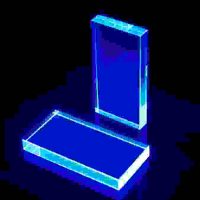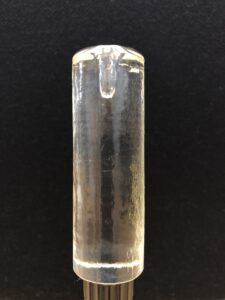High performance,
robust material for
neutron detection
Home / Technologies / Glass
Lithium-6 (6Li) Glass
An Introduction to Lithium-6 Glass

Customisable to your requirements, the excellent sensitivity of our lithium-based glass scintillators allows for reliable, high sensitivity neutron detection.
Scintacor offers three types of Ce-activated lithium aluminosilicate glasses distinguished by their different lithium contents:
- 2.4%
- 6.6%
- 7.5%
each is available at three 6Li isotope enrichment levels:
- Natural
- 95%
- Depleted (<0.01%)
giving the range of 9 possible formulations shown in table 1.
Table 1 Lithium Content & Isotopic Enrichmant by Type
Natural
Lithium-6 Enriched
Lithium-6 Depleted
Natural
Type | Total Lithium (wt%) | Isotopic Enrichment |
GS1 | 2.4% | Natural |
GS10 | 6.6% | Natural |
KG1 | 7.5% | Natural |
Lithium-6 Enriched
Type | Total Lithium (wt%) | Isotopic Enrichment |
GS2 | 2.4% | 95% 6Li |
GS20® | 6.6% | 95% 6Li |
KG2 | 7.5% | 95% 6Li |
Lithium-6 Depleted
Type | Total Lithium (wt%) | Isotopic Enrichment |
GS3 | 2.4% | 99.99% 7Li |
GS30 | 6.6% | 99.99% 7Li |
KG3 | 7.5% | 99.99% 7Li |
The motivation for these different formulations comes from efforts to balance two trends: Increasing Li content reduces light output but increasing 6Li content increases sensitivity to thermal neutrons. A variant without 6Li is useful for comparison purposes.
Section 3.1 of the Tyrrell review article [1] and one of the references it contains [15] cover the development of these products and form the basis for this summary. There were two independent developments which gave results consistent one with the other. Levy West Labs, a Scintacor precursor, developed a robust manufacturing method and was the source of materials studied by Spowart.
Scintacor’s glasses are mixes of the oxides of Si, Mg, Al, Ce, Li, namely SiO2, MgO, Al2O3, Ce2O3, Li2O. These products are melted and heat-treated in a controlled atmosphere before being cast and cooled to an intermediate size and shape. The parts are then machined to the required size and shape, before being polished to the customers’ specifications.

Often the geometry is chosen to optimize neutron sensitivity including minimising gamma response. A solid cylinder – essentially the polished billet – would be a good neutron detector even with natural 6Li enrichment (GS10). Sensitivity, however, increases with enrichment so that, in the case of GS20®, only a few mm of material is needed to detect all thermal neutrons incident on the cylinder’s surface. This means that the centre of the cylinder can be removed. Removing the core reduces overall neutron sensitivity slightly because the surface area at the end of the cylinder is also removed, but the gamma response is reduced even further because this more-penetrating radiation interacts with the full volume and not just the surface. The corresponding reduction in detector mass can also be advantageous in some situations.
Custom glass scintillators can be manufactured in many geometries such as discs, rectangles and cylinders with typical flat dimensions range from 10 to 200mm and thickness from 1 to 50mm.
Our glass can also be supplied in powder form with average particle size in the range 20µm to 1,000µm for use in flow cell radio-detectors for high-performance liquid chromatography (HPLC).
Thermal Neutron Detection
Neutrons and neutron detectors are useful in a number of applications including neutron radiography, density tools, isotope identification, security (search for atomic bombs or parts thereof) and various science experiments including neutron time of flight. Neutron dosimetry is also important because irradiation of the body poses health risks.
Free neutrons, that is neutrons outside the atomic nucleus, are initially energetic ’fast’ neutrons typically with MeV levels of energy. This is because they issue from energetic events, nuclear decay or fission in isotopic sources, or nuclear reactions that are enabled by small accelerators in neutron generators or fission and many radioactive elements in operating atomic reactors.
Free neutrons interact primarily with atomic nuclei in the surroundings. This is in contrast to gamma-rays which interact primarily with atomic electrons. The neutron may react with the nucleus in which case we say that it is captured, or it may bounce off and we say that the neutron is scattered. The probability of interaction is summarized in a parameter called cross-section, which varies significantly with neutron energy.
The fast neutrons from a source are best slowed by hydrogen nuclei (protons) both because the cross section is high and because the proton recoil absorbs relatively more of the neutron’s energy. Hydrogen rich materials like high-density polyethylene (HDPE) are used for slowing the neutrons. Slowing is also called moderation and the material used is a moderator. Scattering continues as the neutron energy falls until the neutron reaches thermal energies of about 0.025 eV at room temperature. Usually the process ends when the neutron is captured by a nucleus. Capture cross-sections for most isotopes rise as energy drops. If capture does not occur the neutrons decay into an electron and a proton with a half-life of just over 10 minutes.
Scintacor offers neutron detection using lithium bearing scintillation materials. Our products are:
- Ce-doped lithium aluminosilicate glasses
- Screens composed of a powder mix of 6LiF and ZnO or ZnS scintillator.
Lithium is selected because 6Li has a large capture cross-section (940 barn) for thermal neutrons and their capture in 6Li produces energetic particles, with short ranges in solids, via the following mechanism.
n + 6Li → α + 3H + 4.78 MeV
The secondary particles of this reaction lose their energy within the surrounding scintillator material, close to the interaction point, emitting visible light.
GS20® glass produces ~6000 photons per absorbed neutron, is generally transparent to its emitted light, and has a relatively fast decay time constant of approximately 70ns which gives good rate capability. The large cross section for 6Li means that even GS10 without enrichment is efficient at thermal neutron capture if dimensions are large enough. For example, a 2cm path in GS10 absorbs over 90% of the incident thermal neutrons. With the enriched GS20, 1mm of the glass provides a detection efficiency of about 75% for thermal neutrons (.025 eV) while 95% can be reached with 2mm of material [3]. Table 2 lists further useful references related to the response of GS20® and KG2 glasses to various neutron energies, while the moderators used at high energies are described in the references.
Table 2
Table 2
Neutron Energy | Scintacor Glass type | Glass Thickness | Reference |
0.01 – 20eV | All Types | 0.1 – 10 mm | [4] |
Thermal | GS20 | 1.3 mm | [5] |
10 eV – 100 KeV | GS20 | 3.2 mm | [6] |
100 eV – 1 MeV | GS20 | 25.4 mm | [7] |
1 – 600 KeV | KG2, GS20 | 9.5 mm | [8] |
1 – 6 MeV | GS20 | 25 mm | [9] |
The Ce-activated aluminosilicate glass scintillators have the same pulse shape when excited with electrons or charged particles. This means that discrimination between gammas and neutrons is done only on a pulse height basis and not with pulse shape discrimination. The thermal neutron peak falls at a gamma equivalent energy a little above 1.6 MeV at room temperature [10], so when the gamma energy reaches the vicinity of 1.6 MeV it cannot be distinguished from the neutron signal. Corrections can be generated for the gamma signal alone using GS30 devoid of 6Li. The use of GS20 with its enrichment makes the neutron detector smaller for a given efficiency and reduces gamma sensitivity compared to GS10 configured for the same neutron sensitivity.
Often a neutron detector’s response to gamma rays present in the radiation field or background limits the ability to detect neutrons. As a result, the gamma/neutron response ratio is sometimes an important specification.
For applications requiring better gamma rejection, Scintacor offers ZnS:Ag/6LiF neutron detecting screens which have much higher light output (150,000 photons/neutron), offer pulse shape discrimination, and can be used as multiple thin layers (which produce small gamma pulses). ZnS:Ag/6LiF is opaque to the emitted light and self-absorption sets a thickness limitation of 450-500μm for light transmission. This impacts on detection efficiency [11]. In addition, while the primary decay time constant of ZnS:Ag/6LiF of 200ns is moderately fast, afterglow can exist for 10s of microseconds and this limits in turn the count rate capability of detectors built with ZnS:Ag/6LiF scintillators [3].
6Li glass Applications
Oil & Gas. GS20® glass has been adopted as the technology of choice by top tier oilfield service companies. The thin-walled precision-machined and polished cylinders are an ideal solution for integration into porosity logging tools. Their ruggedness makes them suitable for use in high temperature and high shock environments. Porosity tools often feature two cylinders arranged in a near and far configuration which detect the unique thermal neutron signature from oil-bearing rocks while discriminating against gamma rays. A fast neutron source is used to irradiate the rocks around the drill bit. The thermalised neutrons resulting from the interaction with oil-bearing rocks are converted by the scintillator into light. This is in turn detected by a photomultiplier tube to give a characteristic thermal neutron peak. The low response of this glass scintillator configuration to gamma allows the neutron peak to be detected without interference from these interactions. This is particularly important in this application since the neutron source used has a high gamma signal.
Neutron Scattering. The 6Li neutron sensitive glass is also used by research institutions and spallation sources around the world in neutron scattering experiments. For example, the ISIS centre at the Rutherford Appleton Laboratory (RAL) utilise GS20® glass scintillators in their VESUVIO instrument; Oak Ridge National Laboratory’s Spallation Neutron Source (ORNL SNS) utilises the glass in the SNAP, TOPAZ and MaNDi instruments. The Jülich Centre for Neutron Science (JCNS) has selected GS20® glass for their current detector prototype for the SoNDe project, a neutron detector designed to cope with extremely high count rates, which will later be shown at the European Spallation Source, currently still under construction in Sweden.
Radiation Detection. GS20® scintillator glass is being successfully used in hand-held neutron detectors due the superior cost to performance ratio to that of other commercially available scintillators such as CLYC and 6Li-Iodide. In February 2015 the U.S. Department of Homeland Security issued a market survey report “Neutron-Detecting Personal Radiation Detectors (PRDs) and Spectroscopic PRDs”, which compared 10 commercially available PRDs and ten SPRDs with neutron detection capability. The gamma neutron pager based around the GS20® glass scored the second highest neutron sensitivity of the instruments in the report, and the manufacturer claims that this PRD exceeds the neutron time-to-alarm requirements of ANSI 42.32-2006 and IEC 62401. [13]
Liquid Chromatography. GS1 fine particles have been widely used in flow-cell detectors designed for the measurement of radionuclide activity in flowing systems. The technology is applied most commonly in the biological sciences to measure the activity of radioisotope-labelled organic compounds in high-performance liquid chromatography (HPLC) effluent streams. Lithium glass is the most rugged solid scintillator and is extremely resistant to contamination. It can also withstand the particularly rigorous decontamination procedures. It gives acceptable but lower counting efficiencies for 14C than either yttrium silicate or calcium fluoride but is rarely used for 3H measurement. Nonetheless, it is the fastest to dark adapt and the least affected by extremes of pH. In comparison to liquid scintillator cocktails (homogenous cells), GS1 fine particles enable a drastic reduction of the effluents volume [14].
contact us for further information
References
[1] G. C. Tyrrel. Phosphors and scintillators in radiation imaging detectors
[2] A. Paul, R.W. Douglas, Phys. Chem. Glasses 6 (1965) 212.
[3] Günter Kemmerling, Sebastian Jaksch, FZJ, Solid-State Neutron Detector INFRADEV-1-2014/H2020, Grant Agreement Number: 654124
[4] L.A. Wraight, Nucl. Instr. & Meth., 33, 181-193 (1965)
[5] A.R. Spowart, “Measurement of the absolute scintillation efficiency of granular and glass neutron scintillators” Nucl Instr. and Meth., 75, 35-42 (1969)
[6] M.S. Coates et al, AERE-PR/NP11, p. 7-8 (1966)
[7] J. Camera et al, Nucl. Instr. & Meth., 42, 277-282 (1966)
[8] H.O. Zetterstrom et al, Nucl. Instr. & Meth., 42, 277-282 (1966)
[9] E. Fort et al, Nucl. Instr. & Meth., 85, 115-123 (1970)
[10] Y. Oshima et all “Temperature Dependence of Li-Glass Scintillator Response to Neutrons”, Nuclear Science and Technology, Vol. 1, p.296-299 (2011)
[11] N.J. Rhodes , Scientific Reviews: Status and Future Development of Neutron Scintillation Detectors, Pages 16-18 | Published online: 21 Aug 2006
[12] A.R. Spowart, Nucl. Instr. & Meth., 82, 1-6 (1970)
[13] U.S. Department of Homeland Security, Science and Technology Directorate, “The Neutron-Detecting Personal Radiation Detectors (PRDs) and Spectroscopic PRDs Market Survey Report” (2015).
[14] PerkinElmer, Inc. Radiomatic Flow Scintillation, P11019 11/03 Printed in U.S.A.
[15] A.R. Spowart, Nucl. Instr. and Meth. 135 (1976) 441
Contact Us
+44 (0)1223 223 060
info@scintacor.com
Contact Form


